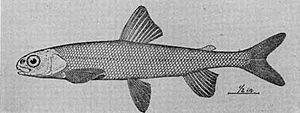Pygmy whitefish facts for kids
Quick facts for kids Pygmy whitefish |
|
|---|---|
 |
|
| Scientific classification |
The pygmy whitefish (Prosopium coulterii) is a small, silvery fish that lives in freshwater. It's part of the Salmonidae family, which also includes salmon and trout. You can find this fish in mountain streams and lakes in western North America. There are also groups of them living far away in Lake Superior and in Ekityki Lake in Russia.
Contents
What the Pygmy Whitefish Looks Like
The pygmy whitefish is a small fish that looks a bit like a herring. It has a long, round body, which is different from other whitefish. Its body is silvery, with a brownish back and a whitish belly.
Young pygmy whitefish have black spots on their sides called "parr marks." These marks are also seen on young trout. Some adult pygmy whitefish in Alaska keep these spots too.
This fish is usually about 12 centimetres (4.7 in) long, but it can grow up to 28 centimetres (11 in). You can tell it apart by its small size and its big eyes. Its eyes are actually bigger than its blunt nose!
The fins on its back and sides are usually clear. Its tail is clear with a faint dark spot. The fins on its belly are plain whitish. This fish has large scales, and fewer gill rakers than other similar fish. These features show it's a bit different from other Prosopium fish. Scientists think it's one of the oldest types in its group. It's also the most trout-like fish in a group that is already considered very similar to trout.
How Scientists Name and Group the Pygmy Whitefish
The pygmy whitefish was first described by scientists Carl H. Eigenmann and Rosa Smith Eigenmann in 1892. They named it Coregonus coulteri after a famous plant scientist, John Merle Coulter.
Since then, it has been placed in a different group called Prosopium. This group includes whitefish that are considered more "primitive," meaning they have older features. Fish in the Prosopium group are different from other whitefish because they have:
- Only one flap of skin over their nostril (instead of two).
- "Parr marks" like trout and char.
- A round body.
- A small mouth without teeth.
The name Prosopium comes from a Greek word meaning "mask." This refers to the large bones in front of the fish's eyes.
Where the Pygmy Whitefish Lives
You can find the pygmy whitefish mostly in the northern Rocky Mountains. But there are also three other groups of them living far away from each other. One group is in Lake Superior in North America. Another is in southwestern Alaska. The third is in Ekityki Lake in the Chukchi Peninsula, Russia.
Scientists believe that the pygmy whitefish used to live all across these areas until the end of the last Ice Age, called the Pleistocene period.
In the Rocky Mountains, these fish like cold, fast-moving streams. They also live in cool lakes at depths of more than 6 metres (20 ft). In Lake Superior, they prefer even cooler water, found at depths between 18 to 89 metres (59 to 292 ft).
Life and Habits
Reproduction
In Lake Superior, pygmy whitefish lay their eggs in November and December. They do this in deep water, about 31 to 46 metres (102 to 151 ft) down. A female fish lays about 362 orange eggs, each about 2.57 millimetres (0.101 in) wide.
In other places, the pygmy whitefish swims upstream to lay its eggs. This usually happens in November or December in streams with gravel bottoms.
What They Eat
Pygmy whitefish mainly eat the young forms (called larvae) of insects that live in water. They also eat small crustaceans, which are like tiny shrimp or crabs.
In Lake Superior, a type of crustacean called Pontoporeia makes up most of their diet. They also eat other small crustaceans, especially ostracods. These tiny creatures make up about 77 percent of what the pygmy whitefish eats.
Predators
Several animals like to eat pygmy whitefish. These include the burbot (a type of fish), kingfishers (birds that catch fish), terns (another type of bird), and pikes (large fish).
See also
 In Spanish: Prosopium coulterii para niños
In Spanish: Prosopium coulterii para niños

